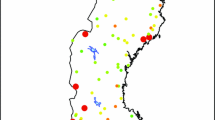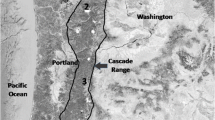Abstract
The sensitivity of surface waters to acidic deposition is governed by the interaction of catchment geology, soils, topography, land use, climate and atmospheric deposition. Accordingly at the landscape scale, catchment attributes may be used to predict lake chemistry (for example, acid neutralising capacity (ANC), pH, calcium (Ca2+) and dissolved organic carbon (DOC)). Empirical (multiple linear regression) models based on average measured chemistry (2000–2006) for 204 lakes in Nova Scotia (NS) Canada, and their catchment attributes, were used to predict chemistry for all lakes in NS (n = 6104). Damage to aquatic biota, such as loss of species and/or reduced biodiversity has been widely evaluated using critical chemical thresholds commonly based on pH, ANC and Ca2+. The proportion of sensitive lakes in NS (that is, the stock at risk) was estimated as lakes with ANC less than 20 μeq l−1, pH below 6, and Ca2+ less than 75 μeq l−1 (13, 73 and 74%, respectively). Many lakes in NS are characterized by high DOC (>7 mg l−1); in these lakes organic acids contribute to total acidity, making anthropogenic influences difficult to discern. To account for the potential contribution of organic acidity, all lakes with pH below 6 (and DOC < 7 mg l−1) and lakes below a threshold for ANC adjusted for organic acids were quantified; 63% of the lakes fell below either of these thresholds. Despite substantial reductions in sulphur emissions in North America since the 1980s, many lakes in NS remain at risk to acidic deposition.





Similar content being viewed by others
References
Aber JD, Melillo JM. 1991. Terrestrial ecosystems. Philadelphia (PA): Saunders College Publishing. p 430.
Ashforth D, Yan ND. 2008. The interactive effects of calcium concentration and temperature on the survival and reproduction of Daphnia pulex at high and low food concentrations. Limnolology and Oceanography 53(2):420–32.
Babyak MA. 2004. What you see may not be what you get: a brief, nontechnical introduction to overfitting in regression-type models. Psychosomatic Medicine 66:411–21.
Baker JP, Gherini SA, Christensen SW, Driscoll CT, Gallagher J, Munson RK, Newton RM. 1990. Adirondack Lake Survey: an interpretive analysis of fish communities and water chemistry, 1984–87. Ray Brook, NY: Adirondack Lakes Survey Corporation.
Berg NH, Gellegos A, Dell T, Grazier J, Procter T, Sickman J, Grant S, Blett T, Arbaugh M. 2005. A screening procedure for identifying acid-sensitive lakes from catchment characteristics. Environmental Monitoring and Assessment 105:285–307.
Burnham KP, Anderson DR. 2000. Model selection and inference: a practical information-theoretic approach. New York (NY): Springer Science + Business Media, LLC. p 488.
Clair TA, Dennis IF, Vet R. 2011. Water chemistry and dissolved organic carbon trends in lakes from Canada’s Atlantic Provinces: no recovery from acidification measured after 25 years of lake monitoring. Canadian Journal of Fisheries and Aquatic Sciences 68:663–74.
Clair TA, Dennis IF, Scruton DA, Gilliss M. 2007. Freshwater acidification research in Atlantic Canada: a review of results and predictions for the future. Environmental Reviews 15:153–67.
Clair TA, Ehrman JM, Ouellet AJ, Brun GL, Lockerbie D, Ro C-U. 2002. Changes in freshwater acidification trends in Canada’s Atlantic Provinces: 1983–1997. Water Air and Soil Pollution 135:335–54.
Clair TA, Pollock TL, Ehrman JM. 1994. Exports of carbon and nitrogen from river basins in Canada’s Atlantic provinces. Global Biogeochemical Cycles 8:441–50.
Clow DW, Nanus L, Huggett B. 2010. Use of regression-based models to map sensitivity of aquatic resources to atmospheric deposition in Yosemite National Park, USA. Water Resources Research 46. doi:10.1029/2009WR008316.
Clow DW, Sueker JK. 2000. Relations between basin characteristics and stream water in alpine/subalpine basins in Rocky Mountain National Park, Colorado. Water Resources Research 36:49–61.
Creed IF, Sanford SE, Beall FD, Molot LA, Dillon PJ. 2003. Cryptic wetlands: integrating hidden wetlands in regression models of the export of dissolved organic carbon from forested landscapes. Hydrological Processes 17:3629–48.
D’Arcy P, Carignan R. 1997. Influence of catchment topography on water chemistry in southeastern Quebec Shield lakes. Canadian Journal of Fisheries and Aquatic Sciences 54:2215–27.
Dillon PJ, Molot LA. 1997. Effect of landscape form on export of dissolved organic carbon, iron, and phosphorus from forested stream catchments. Water Resources Research 33:2591–600.
Driscoll CT, Fallon-Lambert K, Chen L. 2005. Acidic deposition: sources and effects. In: Anderson MG, Ed. Encyclopedia of hydrological sciences. New York: John Wiley & Sons Ltd. pp 1441–57.
Engstrom DR. 1987. Influence of vegetation and hydrology on the humus budgets of Labrador lakes. Canadian Journal of Fisheries and Aquatic Sciences 44:1306–14.
Esterby SR, El-Shaarawi AH, Howell GD, Clair TA. 1989. Spatial characteristics of acidification related parameters in sensitive regions of Atlantic Canada. Water Air and Soil Pollution 46:289–303.
Frost PC, Larson JH, Johnston CA, Young KC, Maurice PA, Lamberti GA, Bridgham SD. 2006. Landscape predictors of stream dissolved organic matter concentration and physicochemistry in a Lake Superior river watershed. Aquatic Science 68:40–51.
Gergel SE, Turner MG, Kratz TK. 1999. Dissolved organic carbon as an indicator of the scale of watershed influence on lakes and rivers. Ecological Applications 9(4):1377–90.
Hair JF, Black WC, Babin B, Anderson R, Tatham RL. 2005. Multivariate data analysis. 6th edn. Upper Saddle River (NJ): Prentice Hall. p 928.
Hall JR, Wright SM, Sparks TH, Ullyett J, Allot TEH, Hornung M. 1995. Predicting freshwater critical loads from national data on geology, soils and land use. Water Air and Soil Pollution 85:2443–8.
Hanson PC, Bade DL, Carpenter SR, Kratz TK. 2003. Lake metabolism: relationships with dissolved organic carbon and phosphorus. Limnology and Oceanography 48:1112–19.
Henriksen A, Kamari J, Posch M, Wilander A. 1992. Critical loads of acidity: Nordic surface waters. Ambio 21:356–63.
Hindar A, Henriksen A, Sandoy S, Romundstad AJ. 1998. Critical load concept to set restoration goals for liming acidified Norwegian waters. Restoration Ecology 6:353–63.
Hornung M, Bull KR, Cresser M, Ullyett J, Hall JR, Langan S, Loveland PJ. 1995. The sensitivity of surface waters of Great Britain to acidification predicted from catchment characteristics. Environmental Pollution 87:207–14.
Hornung M, Le Grice S, Brown N, Norris D. 1990. The role of geology and soils in controlling surface water acidity in Wales. Edwards RW, Gee AS, Stoner JH, Eds. Acid waters in Wales. Heidelberg, The Netherlands: Kluwer Academic Publishers. pp 55–66.
Hruska J, Kohler S, Laudon H, Bishop K. 2001. Comparison of acid-base character of organic acids in boreal zone of Sweden and mountainous regions in the Czech Republic. Water Air and Soil Pollution (S4-2):100 (Abstract Book Sixth International Conference on Acid Deposition).
Ito M, Mitchell MJ, Driscoll CT, Roy KM. 2005. Factors affecting acid neutralizing capacity in the Adirondack Region of New York: a solute mass balance approach. Environmental Science and Technology 39:4076–81.
Jeffries DS, Clair TA, Couture S, Franklyn J, Gagnon C, Keller W, McNicol DK, Norouzian F, Weeber RC. 2005a. Current chemical status. 2004 Canadian acid deposition science assessment. Burlington, ON: Environment Canada, National Water Research Institute. pp 206–13.
Jeffries DS, Clair TA, Couture S, Dillon PJ, Franklyn J, Keller W, McNicol DK, Norouzian F, Paterson AM, Turner MA, Weeber RC. 2005b. Trend analyses. In: 2004 Canadian acid deposition science assessment. Burlington, ON: Environment Canada, National Water Research Institute. pp 217–24.
Jeffries DS, Lam DCL, Wong I, Moran MD. 2000. Assessment of changes in lake pH in southeastern Canada arising from present levels and expected reductions in acidic deposition. Canadian Journal of Fisheries and Aquatic Science 57(Suppl 2):40–9.
Jeziorski A, Yan ND, Paterson AM, DeSellas AM, Turner MA, Jeffries DS, Keller B, Weeber RC, McNicol DK, Palmer ME, McIver K, Arseneau K, Ginn BK, Cumming BF, Smol JP. 2008. The widespread threat of calcium decline in fresh waters. Science 322:1374–7.
Kernan MR, Helliwell RC, Hughes MJ. 2001. Predicting freshwater critical loads from catchment characteristics using national datasets. Water Air and Soil Pollution Focus 1:415–35.
Kernan MR, Allott TEH, Batterbee RW. 1998. Predicting freshwater critical loads of acidification at the catchment scale: an empirical model. Water Air and Soil Pollution 105:31–41.
Kramer JR. 1976. Geochemical and lithological factors in acid precipitation. In: Dochinger LS, Seliga TA, Eds. Proceedings of the first international symposium on acid precipitation and the forest ecosystem. Gen. Tech. Rep. NE-23. Upper Darby (PA): U.S. Department of Agriculture, Forest Service, Northeastern Forest Experiment Station. pp 611–18.
Lien L, Raddum GG, Fjellheim A. 1992. Critical loads for surface waters: invertebrates and fish. Oslo, Norway: Norwegian Institute for Water Research. p 36. (Frarapport Nr. 23).
Lydersen E, Larssen T, Fjeld E. 2004. The influence of total organic carbon (TOC) on the relationship between acid neutralizing capacity (ANC) and fish status in Norwegian lakes. Science of the Total Environment 326:63–9.
McDowell WH. 1998. Internal nutrient fluxes in a Puerto Rican rain forest. Journal of Tropical Ecology 14:521–36.
Niemi D. 2005. Emissions of pollutants related to acid deposition in North America. 2004 Canadian acid deposition science assessment. Burlington, ON: Environment Canada, National Water Research Institute. pp 5–14.
Posch M, Kamari J, Forsius M, Henriksen A, Wilander A. 1997. Exceedance of critical loads for lakes in Finland, Norway and Sweden: reduction requirements for acidifying nitrogen and sulfur deposition. Environmental Management 21:291–304.
Rasmussen JB, Godbout L, Schallenberg M. 1989. The humic content of lake water and its relationship to watershed and lake morphometry. Limnology and Oceanography 34:1336–43.
Reuss JO, Cosby BJ, Wright RF. 1987. Chemical processes governing soil and water acidification. Nature 329:27–32.
Schindler DW. 1971. A hypothesis to explain differences and similarities among lakes in the Experimental Lakes Area, northwestern Ontario. Journal of the Fisheries Research Board of Canada 28:295–300.
Shilts WW. 1981. Sensitivity of bedrock to acid precipitation: modification by glacial processes. Paper 81–14. Ottawa, ON: Geological Survey of Canada. p 7.
Skjelkvåle BL, Stoddard JL, Jeffries DS, Tørseth K, Høgåsen T, Bowman J, Mannio J, Monteith DT, Mosello R, Rogora M, Rzychon D, Vesely J, Wieting J, Wilander A, Worsztynowicz A. 2005. Regional scale evidence for improvements in surface water chemistry 1990–2001. Environmental Pollution 137:165–76.
Sullivan TJ, Webb JR, Sayder KU, Herlihy AT, Cosby BJ. 2007. Spatial distribution of acid-sensitive and acid-impacted streams in relation to watershed features in the Southern Appalachian Mountains. Water Air and Soil Pollution 182:57–71.
Turk J. 2001. Field guide for surface water sample and data collection. Washington (DC): USDA Forest Service. p 67. (Air Program).
Watt WD, Scott CD, Zamora PJ, White WJ. 2000. Acid toxicity levels in Nova Scotia rivers have not declined in synchrony with the decline in sulfate levels. Water Air and Soil Pollution 118:203–29.
Whitfield CJ, Aherne J, Watmough SA, Dillon PJ, Clair TA. 2006. Recovery from acidification in Nova Scotia: temporal trends and critical loads for 20 headwater lakes. Canadian Journal of Fisheries and Aquatic Science 63:1504–14.
Wolniewicz M. 2010. Sensitivity, acidification and recovery of lakes in Nova Scotia, Canada. PhD thesis, Trent University.
Zar JH. 1999. Biostatistical analysis. Upper Saddle River (NJ): Prentice Hall. p 662.
Zuur AF, Ieno EN, Elphick CS. 2009. A protocol for data exploration to avoid common statistical problems. Methods in Ecology and Evolution. doi:10.1111/j.2041-210X.2009.00001.x.
Acknowledgments
This work was funded by an NSERC Strategic Grant awarded to P.J. Dillon, and in part, by funding from the Canada Research Chairs Program and an NSERC Discovery grant. We greatly acknowledge Tom Clair (Environment Canada) for providing water quality data and knowledge of the study area. We thank all individuals who contributed to this research, as well as all land owners that allowed access to their property for sampling. The authors appreciate Clinton Ferrey’s assistance in delineation of catchment boundaries. The authors gratefully acknowledge the Canadian National Atmospheric Chemistry (NAtChem) Precipitation Database and its data contributing agencies for the provision of the data sets used in this publication. The agencies responsible for data contributions to the NAtChem/Precipitation Database include Environment Canada and the Province of Nova Scotia.
Author information
Authors and Affiliations
Corresponding author
Additional information
Author Contributions
M.B.W. conceived and designed the study, performed research, data analysis, and wrote the paper; J.A. and P.J.D. contributed to study conception, intellectual content and assisted in writing the paper.
Rights and permissions
About this article
Cite this article
Wolniewicz, M.B., Aherne, J. & Dillon, P.J. Acid Sensitivity of Lakes in Nova Scotia, Canada: Assessment of Lakes at Risk. Ecosystems 14, 1249–1263 (2011). https://doi.org/10.1007/s10021-011-9479-x
Received:
Accepted:
Published:
Issue Date:
DOI: https://doi.org/10.1007/s10021-011-9479-x




